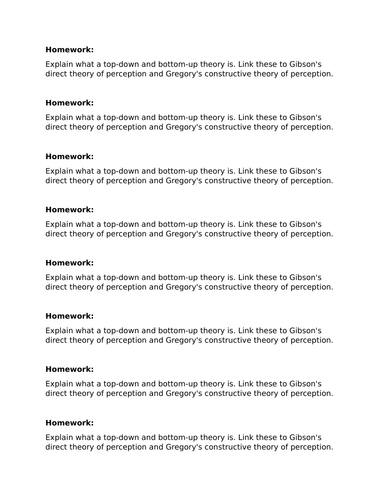




Lesson Point which covers the latter part of 2.5 from the AQA specification 8182 what is constructive perception?
Recap activity on description/explanantion of Gregory’s Direct theory of perception and paired activity for students to demonstrate negative after affect. Students a timer (60 seconds timing), a sheet of A4 plain paper and a green piece of paper cut into a circle . (other bright coloured paper will work equally as well). After paired activity the link to Gregory’s theory and visual illusions is explained.
Explanation for culture and perception as a strength of Gregory’s constructive theory of perception. Then explanations of limitations. First, visual illusions not a usual example on everyday life, explanantion on Muller-Lyer illusion questioned and Gregory’s theory not explaining how perception started.
PowerPoint then focuses on the exam question Describe and evaluate Gregory’s constructive theory of perception (9 marks). The slide shows annotation of the exam question breaking the marks down to A01 and A03 and descriptions for each of the two LO are included. Mark scheme for A01 and A03 features are included. Top tips shared with students on how to achieve higher marks.
Example answers are included. I print one copy out for students to annotate and discuss with an agreed mark in pairs using the mark scheme provided, then I provide an the annotated version and discuss the answers with them suggesting areas for improvement.
Students are to plan what content they will put in the 9 mark answer and separate it into the A01/A03 features.
Students then have 9 minutes in assessment conditions to answer the question using the plan they made previously. I then get students to peer assess each others work using the mark scheme provided.
Compare and contrast activity of Gibson’s direct theory and Gregory’s constructive theory activity at the end of powerpoint is useful for students to understand the differences between them.
Homework activity included: Explain what a top-down and bottom up theory is. Link these to Gibson’s direct theory of perception and Gregory’s constructive theory of perception.
Progress grid includes the following learning outcomes: Evaluate and Apply knowledge to answer exam questions accurately.
Follows AQA GCSE psychology 8182 LO: 2.5 What is constructive perception?
Paper one: Cognition and behaviour
Get this resource as part of a bundle and save up to 38%
A bundle is a package of resources grouped together to teach a particular topic, or a series of lessons, in one place.
Something went wrong, please try again later.
This resource hasn't been reviewed yet
To ensure quality for our reviews, only customers who have purchased this resource can review it
Report this resourceto let us know if it violates our terms and conditions.
Our customer service team will review your report and will be in touch.
